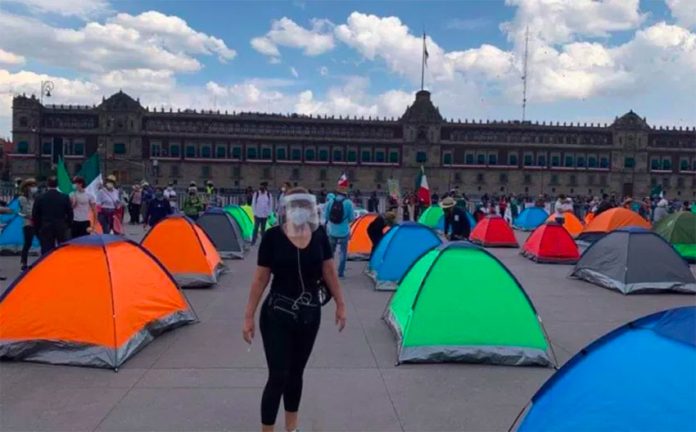Arturo Martínez bustles between tents erected on the main square outside Mexico’s National Palace, issuing instructions with a megaphone, as riot police look on from the other side of a metal barricade.
After four days camped out on the tarmac of a major avenue nearby, prevented from advancing by police, protesters have finally made it to the emblematic central square, the zócalo, to demand the resignation of President Andrés Manuel López Obrador, widely known as AMLO.
“We’re sleeping here, we won’t abandon the tents. We are fighting against 21st-century socialism,” says Martínez, a lawyer. “They can’t evict us.”
About half of the square — which is flanked by the imposing National Palace, the cathedral, the Mexico City government headquarters and the Supreme Court — has been penned off for the coloured tents, some displaying Mexican flags on which the eagle and snake emblem has been replaced by the words “National Anti-Amlo front”, or Frenaaa.
The biggest anti-government protests in López Obrador’s almost two years in office mark growing dissatisfaction with the populist president. Support for López Obrador, which started at a heady 80%, has been eroded by his poor handling of the pandemic, a deepening recession and stubbornly high homicide rates.
He has faced multiple protests, including one by women who took over the National Human Rights Commission for two weeks this month demanding action on gender violence and disappearances, and by farmers in northern Mexico who clashed with police over water resources at a vital dam.
Although his approval ratings remain solid at around 53%, López Obrador has polarized many Mexicans. He advocates tolerance but displays what critics say is a fierce authoritarian streak, and almost every day attacks opponents as “conservatives” whom he says are resisting his drive to purge corruption and transform the country.
López Obrador was swept to office by a grass roots movement after years of campaigning, including a months-long sit-in on Mexico City’s central Reforma Avenue in 2006 after what he claimed were stolen elections.
Now, with protesters camping out on the streets, the people are using López Obrador’s tactics against him.
The Frenaaa protest (a play on the word “stop”), led by retired businessman Gilberto Lozano, claims to have no political aspirations beyond ejecting the president from office as soon as possible.
“He’s going to resign . . . the pressure is just going to escalate,” said Lozano, speaking from a hotel near the makeshift campsite set up last Saturday after riot police blocked demonstrators from taking over the symbolic zócalo.

They only gained access on Wednesday after winning an injunction.
But taking to the streets against López Obrador is a move that may backfire.
“The streets are his base,” said Guadalupe Correa-Cabrera at George Mason University in Arlington, Virginia. “Despite serious criticism and a more articulated opposition, I still see huge support for AMLO’s government … even though results leave a lot to be desired.”
Lozano, a one-time manager at Mexican Coca-Cola bottler and the conglomerate Femsa, is undeterred. What began earlier this year with protests by caravans of cars in more than 200 cities has grown into a nationwide movement, he says, with more protests planned.
“We represent the people who work and pay taxes and create wealth,” he said. Most protesters were middle class, and many retirees.
The president mocked the leaders, urging them to sleep in the tents rather than hotels. In one video shared on social media, a woman with a megaphone was heard appealing for volunteers to stay in the tents.
Lozano, who says he has received death threats and moved indoors for security reasons, said some 700 people a night have been sleeping under canvas despite heavy rain. However, many tents appeared empty.
More demonstrators would be arriving in the coming days to relieve the first groups and “maintain a nearly permanent force,” Lozano said.
Alfonso Ramírez Cuéllar, the head of López Obrador’s Morena party, called Frenaaa a “fascist group that wants to break the political stability we enjoy in Mexico today.”
But López Obrador invited demonstrators to stay, saying he defended freedom of expression.
However, by initially keeping them away from the zócalo, he dictated terms and “won the opening match,” said one government insider, who saw no prospect of social protests translating into electoral risk for the president.
“Those of us who voted for him voted for change and that’s happening — but you have to be patient,” said César Rodríguez, a carpenter.
López Obrador says his opponents can get rid of him by voting him out of office in a referendum scheduled for early 2022 — a reform he introduced that he says ensures a more democratic government. He would even like to bring that vote forward to next June to coincide with midterm elections.
“I don’t think the protest will get rid of him, but people are fed up,” said Mario Acuña, a shopkeeper, who now regrets voting for López Obrador and said he would join the protest if he could.
“Nothing will halt us,” said Lozano. “Together, we are a tsunami.”
© 2020 The Financial Times Ltd. All rights reserved. Please do not copy and paste FT articles and redistribute by email or post to the web.
